// Alba D'Urbano
//

Main;
Projects() {
Esposizione Impraticabile();
Mare();
Der negierte Raum();
Hautnah();
Touch Me;
Stoffwechsel;
Il Sarto Immortale();
Die Wunderschöne Wunde;
Tra cielo e terra;
L'età dell'oro();
Venere;
Private Property();
Monitoraggio;
corpo_insegnante();
Natura Morta(); Redden/Erröten; Son_no;
Airbag;
Collaborations();
Net-Works();
History();
Imprint;
Die Wunderschöne Wunde;
// The Wounderful Wound
//1998
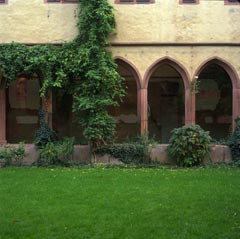 The
project created in the Carmelite Monastery bears the title “Die
Wunderschöne Wunde”, which is a cause for wonder, since wounds
are more customarily associated with pain, not beauty... Hans-Jürgen
Heinrichs describes art in the age of globalisation as “phantom pain”,
and claims that art is about pain. So what do aesthetics and pain have to
do with one-another?
The
project created in the Carmelite Monastery bears the title “Die
Wunderschöne Wunde”, which is a cause for wonder, since wounds
are more customarily associated with pain, not beauty... Hans-Jürgen
Heinrichs describes art in the age of globalisation as “phantom pain”,
and claims that art is about pain. So what do aesthetics and pain have to
do with one-another?
The exhibition is a homage to Jörg Ratgeb, to a tragic artist biography:
A German painter of the early 16th century, influenced by eminent artists
of the Renaissance, while not attaining the same degree of renown. In his
painting he remained somewhat committed to late-gothic naturalism, as can
be observed in the frescos in the Carmelite monastery, completed in 1514-1517.
The process of degeneration of the works had begun early, starting with a
fire that broke out in the 17th century. Over time, the Carmelite monastery
has served several functions, only the west and north walls remain, the frescos
of the entire east wall were almost completely destroyed. In this history
of the decay of the work, Alba D’Urbano sees a parallel to the fate
of the artist himself. Ratgeb aligned himself with the peasants in the Peasants’ War
of 1525 and was executed, drawn and quartered for his political obstinacy.
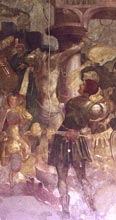
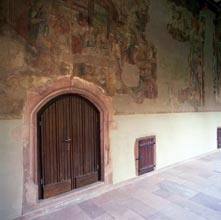
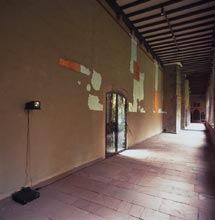
Two previous projects from Alba D’Urbano “Il sarto immortale” and “Hautnah” were
also concerned with wounds and with the artwork as offering. They were essentially
about the artist’s own skin, and reflected the real and metaphorical
meaning of the expression the “artist takes his/her skin to the market”.
At that time, an ancient myth already occurred to me in connection with hers
work, in which the artists since the Renaissance developed an affinity with
their own existence as artists. The myth is about a Silen, the Greek term
for the hybrid creature faun, designating a human being with rams legs by
the name of Marsyas.(...)
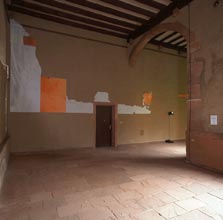
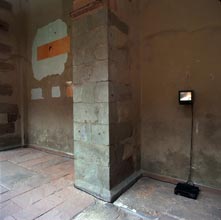
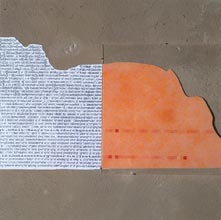
In preparing the installation, outlines of the destruction were photographed,
digitalized and processed together with a photograph of an earlier operative
scar of the artist. Additionally, texts found on the internet by theoreticians
dealing with the subject of art at the end of the millennium were transposed
into pixels, graphically coded, and integrated into the picture. Finally,
these computer print-outs were affixed to the opposite wall of the cloister.
The damaged passages were marked by colour pixel pictures or script characters.
Within the new fresco two small monitors were installed, showing interviews
with local artists, critics, historians, curators, and gallery owners on the
theme of the position of the artist at the end of the millennium. As a reference
to the artwork, the interviews featured only sections of the interviewees’ faces,
or pieces of skin.
Blazenka Perica and Alexandra Kolossa